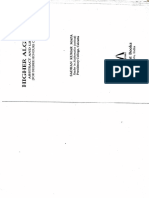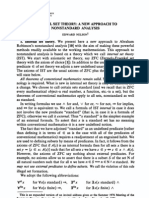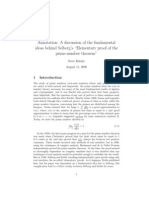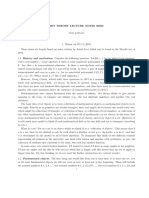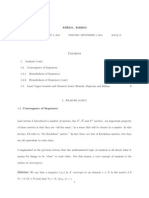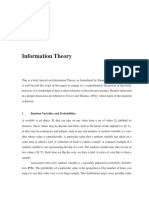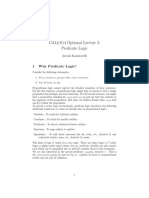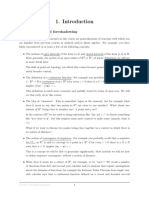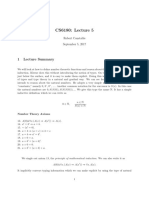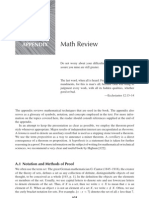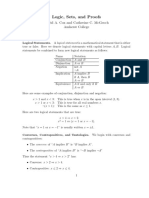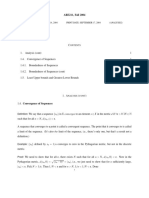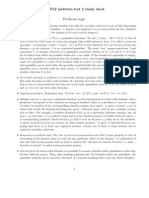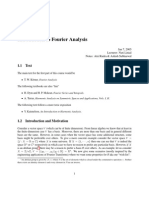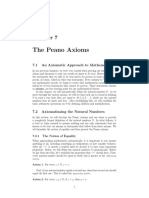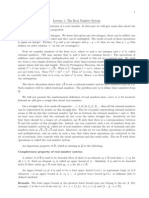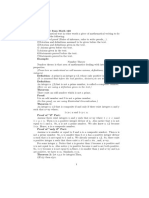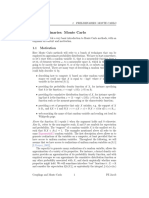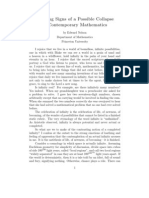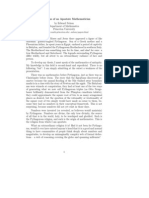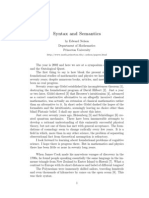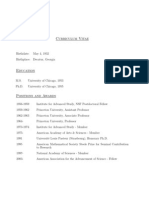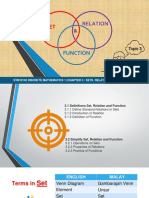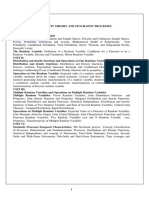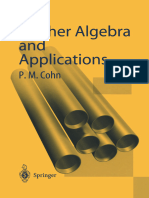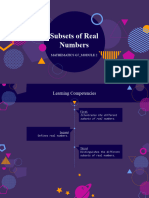Internal Set Theory
Internal Set Theory
Uploaded by
Epic WinCopyright:
Available Formats
Internal Set Theory
Internal Set Theory
Uploaded by
Epic WinOriginal Title
Copyright
Available Formats
Share this document
Did you find this document useful?
Is this content inappropriate?
Copyright:
Available Formats
Internal Set Theory
Internal Set Theory
Uploaded by
Epic WinCopyright:
Available Formats
CHAPTER 1
Internal Set Theory
Ordinarily in mathematics, when one introduces a new concept one
denes it. For example, if this were a book on blobs I would begin with
a denition of this new predicate: x is a blob in case x is a topological
space such that no uncountable subset is Hausdor. Then we would be
all set to study blobs. Fortunately, this is not a book about blobs, and
I want to do something dierent. I want to begin by introducing a new
predicate standard to ordinary mathematics without dening it.
The reason for not dening standard is that it plays a syntacti-
cal, rather than a semantic, role in the theory. It is similar to the use
of xed in informal mathematical discourse. One does not dene this
notion, nor consider the set of all xed natural numbers. The statement
there is a natural number bigger than any xed natural number does
not appear paradoxical. The predicate standard will be used in much
the same way, so that we shall assert there is a natural number bigger
than any standard natural number. But the predicate standard
unlike xedwill be part of the formal language of our theory, and
this will allow us to take the further step of saying, call such a natural
number, one that is bigger than any standard natural number, unlim-
ited.
We shall introduce axioms for handling this new predicate stan-
dard in a consistent way. In doing so, we do not enlarge the world of
mathematical objects in any way, we merely construct a richer language
to discuss the same objects as before. In this way we construct a the-
ory extending ordinary mathematics, called Internal Set Theory
1
that
axiomatizes a portion of Abraham Robinsons nonstandard analysis. In
this construction, nothing in ordinary mathematics is changed.
1
It was rst presented in [Ne] Edward Nelson, Internal set theory: A new ap-
proach to nonstandard analysis, Bulletin American Mathematical Society 83 (1977),
11651198. A good introductory account is [Rt] Alain Robert, Analyse non stan-
dard, Presses polytechniques romandes, EPFL Centre Midi, CH1015 Lausanne,
1985; translated by the author as Nonstandard Analysis, Wiley, New York, 1988.
1
2 CHAPTER 1. INTERNAL SET THEORY
1.1 External concepts
Let us begin by adjoining to ordinary mathematics a new predicate
called standard. Using this new predicate, we can introduce new no-
tions. For example, we can make the following denitions, in which the
variables range over R, the set of all real numbers:
x is innitesimal in case for all standard > 0 we have [x[ ,
x is limited in case for some standard r we have [x[ r,
x y (x is innitely close to y) in case x y is innitesimal,
x y (x is strongly less than y) in case x < y and x , y,
x y (x is strongly greater than y) in case y x,
x in case x 0 and x is unlimited (i.e., not limited),
x in case x ,
x in case x , ,
x in case x , ,
x <
y (x is nearly less than y) in case x y + for some
innitesimal ,
x >
y (x is nearly greater than y) in case y <
x.
A formula of ordinary mathematicsone that does not involve the new
predicate standard, even indirectlyis called internal ; otherwise, a
formula is called external. The eleven denitions given above are all
external formulas.
Notice that the adjectives internal and external are metamath-
ematical conceptsthey are properties of formulas and do not apply to
sets.
One of the basic principles of ordinary mathematics, or internal
mathematics as I shall call it from now on, is the subset axiom. This
asserts that if X is a set then there is a set S, denoted by x X : A,
such that for all x we have x S x X & A. Here A is a formula
of internal mathematics. Usually it will have x as a free variable, but it
may have other free variables as well. When we want to emphasize its
dependence on x, we write it as A(x). Nothing in internal mathematics
has been changed by introducing the new predicate, so the subset axiom
continues to hold. But nothing in internal mathematics refers to the new
predicate, so nothing entitles us to apply the subset axiom to external
formulas. For example, we cannot prove that there exists a set I such
that x I x R & x is innitesimal. The notation x R : x 0
is not allowed; it is an example of illegal set formation. Only internal
1.2 THE TRANSFER PRINCIPLE 3
formulas can be used to dene subsets. (Nevertheless, in Chapter 4 we
shall nd a way to introduce so-called external sets.)
Certain set formations that might at rst sight appear to be illegal
are perfectly legitimate. For example, suppose that we have an innites-
imal x > 0. Then we can form the closed interval [x, x] consisting of
all y such that x y x. This is simply because we already know
that for any x > 0 we can form the set [x, x].
Exercises for Section 1.1
1. Let n be a nonstandard natural number. Can one form the set of all
natural numbers k such that k n? Is this set nite?
2. Can one form the set of all limited real numbers?
3. Can one prove that every standard positive real number is limited?
4. Can one form the set of all standard real numbers x such that x
2
1?
5. Assume that 1 is standard. Can one form the set of all limited real
numbers x such that x
2
1?
6. Can one prove that the sum of two innitesimals is innitesimal?
1.2 The transfer principle
We cannot yet prove anything of interest involving standard be-
cause we have made no assumptions about it. Our rst axiom is the
transfer principle (T).
The notation
st
means for all standard, and
st
means there
exists a standard. Let A be an internal formula whose only free variables
are x, t
1
, . . . , t
n
. Then the transfer principle is
st
t
1
st
t
n
[
st
xA xA]. (1.1)
We may think of the t
1
, . . . , t
n
as parameters; we are mainly inter-
ested in x. Then the transfer principle asserts that if we have an internal
formula A, and all the parameters have standard values, and if we know
that A holds for all standard x, then it holds for all x. (The converse
direction is trivial, and we could have stated (T) with just instead
of .)
The intuition behind (T) is that if something is true for a xed, but
arbitrary, x then it is true for all x.
Notice that two formulas are equivalent if and only if their negations
are. But we have xA xA, so if we apply (T) to A we obtain
the dual form of the transfer principle:
st
t
1
st
t
n
[
st
xA xA]. (1.2)
4 CHAPTER 1. INTERNAL SET THEORY
Let us write A B (A is weakly equivalent to B) to mean that
for all standard values of the free variables in the formulas, we have
A B. Then we can rewrite the two forms of (T) as
st
xA xA and
st
xA xA whenever A is an internal formula. Applying these rules
repeatedly, we see that any internal formula A is weakly equivalent to
the formula A
st
obtained by replacing each by
st
and by
st
. Then
t
1
, . . . , t
n
are standard A
st
,
where t
1
, . . . , t
n
are the free variables in A, is called the relativization
of A to the standard sets.
Consider an object, such as the empty set , the natural numbers N,
or the real numbers R, that can be described uniquely within internal
mathematics. That is, suppose that there is an internal formula A(x)
whose only free variable is x such that we can prove existence xA(x)
and uniqueness A(x
1
) & A(x
2
) x
1
= x
2
. By the dual form of transfer,
st
xA(x); so by uniqueness, the x such that A(x) holds is standard. For
example, let A(x) be y[y / x]. There is a unique set, the empty set ,
that satises A(x). Therefore is standard. The formulas describing N
and R are longer, but by the same reasoning, N and R are standard.
Any object that can be uniquely described within internal mathematics
is standard: the real numbers 0, 1, and , the Hilbert space L
2
(R, dx)
where dx is Lebesgue measure, the rst uncountable ordinal, and the
loop space of the fteen dimensional sphere are all standard. The real
number 10
100
is standard, so if x is innitesimal then [x[ 10
100
.
The same reasoning applies to internal formulas A(x) containing
parametersprovided the parameters have standard values. For exam-
ple, if t is a standard real number then so is sin t (let A(x, t) be x = sin t)
and if X is a standard Banach space so is its dual.
As an example of transfer, we know that for all real x > 0 there is
a natural number n such that nx 1; therefore, for all standard x > 0
there is a standard n such that nx 1. But suppose that x > 0 is
innitesimal. Do we know that there is a natural number n such that
nx 1? Of course; we already know this for all x > 0. But if we try
to argue as followsthere is an n such that nx 1; therefore, by the
dual form of transfer, there is a standard n such that nx 1then we
have made an error: transfer is only valid for the standard values of the
parameters (in this case x) in the formula. This is an example of illegal
transfer. It is the most common error in learning nonstandard analysis.
Before applying transfer, one must make sure that any parameters in
the formulaeven those that may be implicit in the discussionhave
standard values.
1.3 THE IDEALIZATION PRINCIPLE 5
Another form of illegal transfer is the attempt to apply it to an
external formula. For example, consider for all standard natural num-
bers n, the number n is limited; by transfer, all natural numbers are
limited. This is incorrect. Before applying transfer, one must check
two things: that the formula is internal and that all parameters in it
have standard values.
Exercises for Section 1.2
1. Can one prove that the sum of two innitesimals is innitesimal?
2. If r and s are limited, so are r + s and rs.
3. If x 0 and [r[ , then xr 0.
4. If x ,= 0, then x is innitesimal if and only if 1/x is unlimited.
5. Is it true that the innitesimals are a maximal ideal in the integral
domain of limited real numbers? What does the quotient eld look like?
6. Consider the function f: x x
2
on a closed interval. Then f is
bounded, and since it is standard it has a standard bound.Is this reasoning
correct?
7. Let x and y be standard with x <
y. Prove that x y.
1.3 The idealization principle
So far, we have no way to prove that any nonstandard objects exist.
Our next assumption is the idealization principle (I).
The notation
stn
means for all standard nite sets, and
stn
means there exists a standard nite set such that. Also, xX means
for all x in X, and xX means there exists x in X such that. Let A
be an internal formula. Then the idealization principle is
stn
x
yxx
A y
st
xA. (1.3)
There are no particular pitfalls connected with this assumption: we must
just be sure that A is internal. It can contain free variables in addition
to x and y (except for x
).
The intuition behind (I) is that we can only x a nite number of
objects at a time. To say that there is a y such that for all xed x we
have A is the same as saying that for any xed nite set of xs there is
a y such that A holds for all of them.
As a rst application of the idealization principle, let A be the for-
mula y ,= x. Then for every nite set x
, and so in particular for every
standard nite set x
, there is a y such that for all x in x
we have y ,= x.
Therefore, there exists a nonstandard y. The same argument works when
x and y are restricted to range over any innite set. In other words, every
6 CHAPTER 1. INTERNAL SET THEORY
innite set contains a nonstandard element. In particular, there exists a
nonstandard natural number.
By transfer, we know that 0 is standard, and we know that if n
is standard then so is n + 1. Do we have a contradiction here? Why
cant we say that by induction, all natural numbers are standard? The
induction theorem says this: if S is a subset of N such that 0 is in S
and such that whenever n is in S then n + 1 is in S, then S = N. So
to apply induction to prove that every natural number is standard, we
would need a set S such that n is in S if and only if n is standard, and
this we dont have.
As a rough rule of thumb, until one feels at ease with nonstandard
analysis, it is best to apply the familiar rules of internal mathematics
freely to elements, but to be careful when working with sets of elements.
(From a foundational point of view, everything in mathematics is a set.
For example, a real number is an equivalence class of Cauchy sequences
of rational numbers. Even a natural number is a set: the number 0
is the empty set, the number 1 is the set whose only element is 0, the
number 2 is the set whose only elements are 0 and 1, etc. When I
refer to elements or objects rather than to sets, only a psychological
distinction is intended.)
We can prove that certain subsets of R and N do not exist.
Theorem 1. There does not exist S
1
, S
2
, S
3
, S
4
, or S
5
such that,
for all n in N and x in R, we have n S
1
n is standard, n S
2
n
is nonstandard, x S
3
x is limited, x S
4
x is unlimited, or
x S
5
x is innitesimal.
Proof. As we have seen, the existence of S
1
would violate the in-
duction theorem. If S
2
existed we could take S
1
= N S
2
, if S
3
existed
we could take S
1
= NS
3
, if S
4
existed we could take S
3
= R S
4
, and
if S
5
existed we could take S
4
= x R : 1/x S
5
.
This may seem like a negative result, but it is frequently used in
proofs. Suppose that we have shown that a certain internal property
A(x) holds for every innitesimal x; then we automatically know that
A(x) holds for some non-innitesimal x, for otherwise we could let S
5
be the set x R : A(x) . This is called overspill.
By Theorem 1 there is a non-zero innitesimal, for otherwise we
could let S
5
= 0. We can also see this directly from (I). We denote by
R
+
the set of all strictly positive real numbers. For every nite subset
x
of R
+
there is a y in R
+
such that y x for all x in x
. By (I), there
is a y in R
+
such that y x for all standard x in R
+
. That is, there
exists an innitesimal y > 0.
1.3 THE IDEALIZATION PRINCIPLE 7
Notice that in this example, to say that y is smaller than every
element of x
is the same as saying that y is smaller than the least element
of x
, so the nite set really plays no essential role. This situation occurs
so frequently that it is worth discussing it in a general context in which
the idealization principle takes a simpler form. Recall that a directed set
is a set D together with a transitive binary relation such that every
pair of elements in D has an upper bound. For example, R
+
is a directed
set with respect to . (In this example, the minimum of two elements is
an upper bound for them.) Let A be a formula with the free variable x
restricted to range over the directed set D. We say that A lters in x
(with respect to D and ) in case one can show that whenever x z and
A(z), then A(x). (Here A(z) is the formula obtained by substituting z
for each free occurrence of x in A(x), with the understanding that z is
not a bound variable of A.) Suppose that the internal formula A lters
in x. Then the idealization principle takes the simpler form
st
xyA y
st
xA. (1.4)
That is, we can simply interchange the two quantiers.
The idealization principle also has a dual form. If A is internal, then
stn
x
yxx
A y
st
xA. (1.5)
We say that A colters in x in case we can show that whenever x z
and A(x), then A(z). Then (1.5) takes the simpler form:
st
xyA y
st
xA. (1.6)
In practice, there is no need to make the distinction between ltering
and coltering, and I may say lters when colters is correct.
As an example of the dual form, suppose that f: R R is such that
every value of f is limited. Then f is bounded, and even has a standard
bound. To see this, use (1.6), where the ltering relation is on the
values of the function. We know that for all y there exists a standard x
such that [f(y)[ x. Hence there is a standard x such that [f(y)[ x
for all y.
8 CHAPTER 1. INTERNAL SET THEORY
Theorem 2. Let S be a set. Then S is a standard nite set if and
only if every element of S is standard.
Proof. Let S be a standard nite set, and suppose that it contains
a nonstandard y. Then there exists a y in S such that for all standard x
we have y ,= x, so by (I), for all standard nite sets x
, and in particular
for S, there is a y in S such that for all x in S we have y ,= x. This is a
contradiction, so every element of S is standard.
Conversely, suppose that every element of S is standard. We al-
ready know that S must be nite, because every innite set contains a
nonstandard element. Let x and y range over S and apply the dual form
of idealization to the formula x = y. We know that for all y there is a
standard x with x = y, so there is a standard nite set x
such that for
all y there is an x in x
with x = y. Then x
S; that is, S
x
where
denotes the power set. But x
is standard, so by (T)
x
is standard.
Also, x
is nite, so
x
is a standard nite set. By the forward direction
of the theorem established in the preceding paragraph, every element
of
x
is standard, so S is standard.
2
This has the following corollary.
Theorem 3. Let n and k be natural numbers, with n standard and
k n. Then k is standard.
Proof. Let S = k N : k n. By (T), S is standard. It is
nite, so all of its elements are standard.
Therefore we can picture the natural numbers as lying on a tape,
with the standard numbers to the left and the nonstandard numbers to
the right. The demarcation between the two portions is strange: the left
portion is not a set, and neither is the right. I want to emphasize that
we did not start with the left portion and invent a new right portion to
be tacked on to itwe started with the whole tape, the familiar set N
of all natural numbers, and invented a new way of looking at it.
Theorem 4. There is a nite set that contains every standard ob-
ject.
Proof. This is easy. Just apply (I) to the formula x y & y is
nite.
If we think of standard semanticallywith the world of mathe-
matical objects spread out before us, some bearing the label standard
and others notthen these results violate our intuition about nite sets.
But recall what it means to say that X is a nite set. This is an internal
2
I am grateful to Will Schneeberger for pointing out a gap in my rst proof of
this theorem.
1.3 THE IDEALIZATION PRINCIPLE 9
notion, so it means what it has always meant in mathematics. What
has it always meant? There are two equivalent characterizations. For n
in N, we let I
n
= k N : k < n. Then a set X is nite if and only if
there is a bijection of X with I
n
for some n. There is also the Dedekind
characterization: X is nite if and only if there is no bijection of X with
a proper subset of itself. Consider the set I
n
where n is a nonstandard
natural number. This certainly satises the rst property. Nothing was
said about n being standard; this cannot even be formulated within in-
ternal mathematics. But does it satisfy the Dedekind property? Suppose
that we send each nonstandard element of I
n
to its predecessor and leave
the standard elements alone; isnt this a bijection of I
n
with I
n1
? No,
its denition as a function would involve illegal set formation.Perhaps
it is fair to say that nite does not mean what we have always thought
it to mean. What have we always thought it to mean? I used to think
that I knew what I had always thought it to mean, but I no longer think
so. In any case, intuition changes with experience. I nd it intuitive to
think that very, very large natural numbers and very, very small strictly
positive real numbers were there all along, and now we have a suitable
language for discussing them.
Exercises for Section 1.3
1. A natural number is standard if and only if it is limited.
2. Does there exist an unlimited prime?
3. What does the decimal expansion of an innitesimal look like?
4. Let H be a Hilbert space. Does there exist a nite dimensional subspace
containing all of its standard elements? Is it closed?
5. Suppose that the S
n
, for n in N, are a sequence of disjoint sets with
union S, and suppose that every element x in S is in S
n
for some standard n.
Can one show that all but a nite number of them are empty? Can one show
that all but a standard nite number of them are empty?
6. Prove Robinsons lemma: Let n a
n
be a sequence such that a
n
0
for all standard n. Then there is an unlimited N such that a
n
0 for all
n N.
7. Let n a
n
be a sequence such that a
n
for all standard n. Is
there an unlimited N such that a
n
for all n N?
8. We have been saying let x range over X to mean that each xA
should be replaced by x[x X A] and each xA should be replaced by
x[x X & A]. Let
n
X be the set of all non-empty nite subsets of X. Show
that if x ranges over X, then (I) can be written as
st
x
yxx
A y
st
xA
where x
ranges over
n
X.
10 CHAPTER 1. INTERNAL SET THEORY
1.4 The standardization principle
Our nal assumption about the new predicate standard is the
standardization principle (S). It states that
st
X
st
Y
st
z[z Y z X & A]. (1.7)
Here A can be any formula (not containing Y ), external or internal. It
may contain parameters (free variables in addition to z and X).
The intuition behind (S) is that if we have a xed set, then we can
specify a xed subset of it by giving a criterion for judging whether each
xed element is a member of it or not.
Two sets are equal if they have the same elements. By (T), two stan-
dard sets are equal if they have the same standard elements. Therefore,
the standard set Y given by (S) is unique. It is denoted by
S
z X : A,
which may be read as the standard set whose standard elements are
those standard elements of X such that A holds. Unfortunately, any
shortening of this cumbersome phrase is apt to be misleading. For stan-
dard elements z, we have a direct criterion for z to be an element of
S
z X : A, namely that A(z) hold. But for nonstandard elements z,
this is not so. It may happen that z is in
S
z X : A but A(z) does not
hold, and conversely A(z) may hold without z being in
S
z X : A.
For example, let X =
S
z R : z 0 . Then X = 0 since 0 is the
only standard innitesimal. Thus we can have z 0 without z being
in X. Let Y =
S
z R : [z[ . Then Y = R since every standard
number is limited. Thus we can have z Y without z being limited.
The standardization principle is useful in making denitions. Let
x range over the standard set X. When we make a denition of the
form: for x standard, x is something-or-other in case a certain property
holds, this is understood to mean the same as x is something-or-other
in case x
S
x X : a certain property holds . For example, let
f: R R and let us say that for f standard, f is nice in case every
value of f is limited. Thus f is nice if and only if f N, where we
let N =
S
f R
R
: every value of f is limited . (The notation X
Y
signies the set of all functions from Y to X.) I claim that f is nice if
and only if f is bounded. To prove this, we may, by (T), assume that
f is standard. We already saw, in the previous section, that if every
value of f is limited, then f is bounded. Conversely, let f be bounded.
Then by (T) it has a standard bound, and so is nice. This proves the
claim. But, one might object, the rst transfer is illegal because nice
was dened externally. The point is this: being nice is the same as being
1.4 THE STANDARDIZATION PRINCIPLE 11
in the standard set N, so the transfer is legal. In complete detail, (T)
tells us that for all standard N we have
st
f[f N f is bounded] f[f N f is bounded].
In other words, this kind of denition by means of (S) is a way of dening,
somewhat implicitly, an internal property.
Let x and y range over a set V , let y range over V
V
, and let A be
internal. Then
xyA(x, y) yxA
_
x, y(x)
_
.
The forward direction is the axiom of choice, and the backward direction
is trivial. If we apply transfer to this, assuming that V is standard, we
obtain
st
x
st
yA(x, y)
st
y
st
xA
_
x, y(x)
_
.
But we can do much better than this. Let A be any formula, external
or internal. Then
st
x
st
yA(x, y)
st
y
st
xA
_
x, y(x)
_
. (1.8)
The backward direction is trivial, so we need only consider the forward
direction. Suppose rst that for all standard x there is a unique stan-
dard y such that A(x, y). Then we can let y =
S
x, y) : A(x, y) . In
the general case, let
Y =
S
x, Y ) : Y =
S
y : A(x, y) .
Then
Y is a standard set-valued function whose values are non-empty
sets, so by the axiom of choice relativized to the standard sets, it has a
standard cross-section y of the desired form. We call (1.8) the functional
form of standardization (
S). It has a dual form:
st
x
st
yA(x, y)
st
y
st
xA
_
x, y(x)
_
. (1.9)
The requirements in (1.8) and (1.9) are that x and y range over some
standard set V and that y range over V
V
. This includes the case that
x and y range over dierent standard sets X and Y , with y ranging
over Y
X
, because we can always let V = XY and include the conditions
x X and y Y in the formula A.
If X is a set, contained in some standard set V , we let
S
X =
S
x V : x X.
12 CHAPTER 1. INTERNAL SET THEORY
This clearly does not depend on the choice of V , and in practice the
requirement that X be contained in some standard set is not restrictive.
Then
S
X is the unique standard set having the same standard elements
as X. It is easy to see that if f is a function then so is
S
f.
The theory obtained by adjoining (I), (S), and (T) to internal math-
ematics is Internal Set Theory (IST).
So far, we have not proved any theorems of internal mathematics
by these new methods. Here is a rst example of that, a theorem of
de Brujn and Erdos
3
on the coloring of innite graphs.
By a graph I mean a set G together with a subset R of GG. We
dene a k-coloring of G, where k is a natural number, to be a function
g: G 1, . . . , k such that g(x) ,= g(y) whenever x, y) R. An
example is G = R
2
and R = x, y) : [x y[ = 1 where [x y[ is the
Euclidean metric on R
2
. (This graph is known to have a 7-coloring but
no 3-coloring.) The theorem asserts that if every nite subgraph of G
has a k-coloring, so does G. This is not trivial, because if we color a
nite subgraph, we may be forced to go back and change its coloring
to color a larger nite subgraph containing it. To prove the theorem,
we assume, by (T), that G and k are standard. By (I), there is a nite
subgraph F of G containing all its standard elements, and by hypothesis
F has a k-coloring f. Let g =
S
f. Since f takes only standard values,
every standard element of G is in the domain of g. By (T), every element
of G is in the domain of g. To verify that g is a k-coloring, it suces,
by (T), to examine the standard elements, where it agrees with f. This
concludes the proof.
Exercises for Section 1.4
1. Show that if f is a function, so is
S
f. What can one say about its
domain and range?
2. Deduce (S) from (
S).
3. Dene f by f(x) = t/(t
2
+ x
2
) where t > 0 is innitesimal. What is
_
f(x) dx? What is
S
f?
4. Establish external induction: Let A(n) be any formula, external or
internal, containing the free variable n and possibly other parameters. Suppose
that A holds for 0, and that whenever it holds for a standard n it also holds
for n + 1. Then A(n) holds for all standard n.
5. Let the Greek variables range over ordinals. Establish external trans-
nite induction:
st
A()
st
[A() &
st
[A() ]].
6. Deduce (I) from the forward direction of (I).
3
N. G. de Brujn and P. Erdos, A colour problem for innite graphs and a
problem in the theory of relations, Indagationes Mathematicae 13 (1951), 371373.
1.5 ELEMENTARY TOPOLOGY 13
1.5 Elementary topology
In this section I shall illustrate IST with some familiar material. In
the following denitions by (S), we assume that E R, that f: E R,
and that x, y E.
For f and x standard, f is continuous at x in case whenever
y x we have f(y) f(x).
For f and E standard, f is continuous on E in case for all
standard x, whenever y x we have f(y) f(x).
For f and E standard, f is uniformly continuous on E in case
whenever y x we have f(y) f(x).
For E standard, E is compact in case for all x in E there is a
standard x
0
in E with x x
0
.
For E standard, E is open in case for all standard x
0
in E and
all z in R, if z x
0
then z is in E.
For E standard, E is closed in case for all x in E and standard
x
0
in R, if x x
0
then x
0
is in E.
For E standard, E is bounded in case each of its elements is
limited.
It can be shown that these denitions are equivalent to the usual de-
nitions, but rather than worry about that now, let us develop a direct
intuition for these formulations by examining them in various familiar
situations.
Let us prove that [0, 1] is compact. Notice that it is standard. Let x
be in [0, 1]. Then it can be written as x =
n=1
a
n
2
n
where each a
n
is
0 or 1, and conversely each number of this form is in [0, 1]. This binary
expansion is determined by a function a: N
+
0, 1. Let b =
S
a. Then
b
n
= a
n
for all standard n, so if we let x
0
=
n=1
b
n
2
n
then x
0
is
standard, x
0
x, and x
0
is in [0, 1]. Therefore [0, 1] is compact. This
has the following corollary.
Theorem 5. Each limited real number is innitely close to a unique
standard real number.
Proof. Let x be limited. Then [x] is a limited, and therefore stan-
dard, integer. Since x [x] is in the standard compact set [0, 1], there
is a standard y
0
innitely close to it, so if we let x
0
= y
0
+ [x] then x
0
is standard and innitely close to x. The uniqueness is clear, since 0 is
the only standard innitesimal.
14 CHAPTER 1. INTERNAL SET THEORY
If x is limited, the standard number that is innitely close to it is
called the standard part of x, and is denoted by st x.
Now let us prove that a continuous function f on a compact set E
is bounded. By (T), we assume them to be standard. Let K , and
let x be in E. It suces to show that f(x) K. There is a standard
x
0
in E with x x
0
, and since f(x
0
) is standard we have f(x
0
) K.
But by the continuity of the standard function f we have f(x) f(x
0
),
so f(x) K, which concludes the proof. (It may seem like cheating
to produce an unlimited bound. By (T), if a standard function f is
bounded, then it has a standard bound. But this is a distinction that
can be made only in nonstandard analysis.)
Somewhat more ambitiously, let us show that a continuous func-
tion f on a compact set E achieves its maximum. Again, we assume
them to be standard. By (I), there is a nite subset F of E that con-
tains all the standard points, and the restriction of f to the nite set F
certainly achieves its maximum on F at some point x. By compactness
and continuity, there is a standard x
0
in E with x
0
x and f(x
0
) f(x).
Therefore f(x
0
) >
f(y) for all y in F. Since every standard y is in F, we
have f(x
0
) >
f(y) whenever y is standard, but since both numbers are
standard we must have f(x
0
) f(y) whenever y is standard. By (T),
this holds for all y, and the proof is complete.
The same device can be used to prove that if f is continuous on [0, 1]
with f(0) 0 and f(1) 0, then f(x) = 0 for some x in [0, 1].
The proof that a continuous function on a compact set is uniformly
continuous requires no thought; it is a simple verication from the def-
initions. It is equally easy to prove that a subset of R is compact if
and only if it is closed and bounded (use Theorem 5 for the backward
direction).
All of this extends to R
n
. Notice that R
n
is standard if and only if
n is, so in the denitions by (S), include for n standard. For a general
metric space X, d), where d is the metric, we dene x y to mean that
d(x, y) is innitesimal. Much of what was done above extends to metric
spaces. In denitions by (S), include for X and d standard. For X
and d standard, a metric space X, d) is complete in case for all x, if for
all standard > 0 there is a standard y with d(x, y) , then there is a
standard x
0
with x x
0
. This is equivalent to the usual denition.
I shall sketch a proof of the Baire category theorem to illustrate an
important point about nonstandard analysis. Let X, d) be a complete
non-empty metric space, and let the U
n
be a sequence of open dense sets
with intersection U. We want to show that U is non-empty. We denote
the -neighborhood of x by N(, x). There are x
1
and 0 <
1
< 1/2
1.5 ELEMENTARY TOPOLOGY 15
such that N(
1
, x
1
) U
1
. Since U
2
is open and dense, there are x
2
and
0 <
2
< 1/2
2
such that N(
2
, x
2
) U
2
N(
1
/2, x
1
). Continue in this
way by induction, constructing a Cauchy sequence x
n
that converges to
some point x, since X is complete. This x is in each U
n
, and so is in U.
This proof is just the usual proof, and that is the important point.
Nonstandard analysis is not an alternative to internal mathematics, it
is an addition. By the nature of this book, almost all of the material
consists of nonstandard analysis, but I emphatically want to avoid giv-
ing the impression that it should somehow be separated from internal
mathematics. Nonstandard analysis supplements, but does not replace,
internal mathematics.
Let X be a standard topological space, and let x be a standard
point in it. Then we dene the relation y x to mean that y is in every
standard neighborhood of x. The external discussion of continuity and
compactness given above for R extends to this setting.
Let E be a subset of the standard topological space X. Then we
dene the shadow of E, denoted by
E, as follows:
E =
S
x X : y x for some y in E . (1.10)
Theorem 6. Let E be a subset of the standard topological space X.
Then the shadow of E is closed.
Proof. Let z be a standard point of X in the closure of
E. Then
every open neighborhood of z contains a point of
E, so by (T) every
standard open neighborhood U of z contains a standard point x of
E.
But for a standard point x of
E, there is a y in E with y x, so y is
in U. That is to say,
st
Uy[y E U]. The open neighborhoods of
z are a directed set under inclusion and this formula lters in U, so by
the simplied version (1.4) of (I) we have y
st
U[y E U]; that is,
yE[y z]. Thus z is in
E. We have shown that every standard point
z in the closure of
E is in
E, so by (T) every point z in the closure of
E is in
E. Thus
E is closed.
There is a beautiful nonstandard proof of the Tychonov theorem.
Let T be a set, let X
t
for each t in T be a compact topological space, and
let be the Cartesian product =
tT
X
t
with the product topology.
We want to show that is compact. By (T), we assume that t X
t
is
standard, so that is also standard. Let be in . For all standard t
there is a standard point y in X
t
such that y (t), so by (
S) there is
a standard in such that for all standard t we have (t) (t). By
the denition of the product topology, , so is compact.
16 CHAPTER 1. INTERNAL SET THEORY
Exercises for Section 1.5
1. Precisely how is (
S) used in the proof of the Tychonov theorem?
2. Let X be a compact topological space, f a continuous mapping of X
onto Y . Show that Y is compact.
3. Is the shadow of a connected set connected?
4. Let x be in R. What is the shadow of |x?
5. Let f(x) = t/(t
2
+ x
2
), where t > 0 is innitesimal. What is the
shadow of the graph of f?
6. Let E be a regular polygon of n sides inscribed in the unit circle. What
is the shadow of E?
1.6 Reduction of external formulas
It turns out that (with a proviso which I shall discuss shortly) every
external formula can be reduced to a weakly equivalent internal formula.
This is accomplished by a kind of formal, almost algebraic, manipulation
of formulas, using (
S) and (I) to push the external quantiers
st
and
st
to the left of the internal quantiers and , and then using (T) to
get rid of them entirely. In this way we can show that the denitions
made using (S) in the previous section are equivalent to the usual ones.
More interestingly, we can reduce the rather weird external theorems
that we have proved to equivalent internal form. The proviso, which has
only nuisance value, is that whenever we use (
S) to introduce a standard
function y(x), then x and y must be restricted to range over a standard
set, to give the function y a domain. (Actually, it suces to make this
restriction on x alone.) I will not make this explicit all of the time.
To reduce a formula, rst eliminate all external predicates, replacing
them by their denitions until only standard is left. Even this should
be eliminated, replacing x is standard by
st
y[y = x].
Second, look for an internal quantier that has some external quan-
tiers in its scope. (If this never happens, we are ready to apply (T) to
obtain a weakly equivalent internal formula.) If the internal quantier
is , use (
S) to pull the
st
s to the left of the
st
s (if necessary, thereby
introducing standard functions), where they can then be pulled to the
left of . If the internal quantier is , proceed by duality.
Third, whenever y
st
xA (or its dual) occurs with A internal, use
(I), taking advantage of its simplication (1.4) whenever A lters in x.
One thing to remember in using this reduction algorithm is that the
implication
st
xA(x) B is equivalent to
st
x[A(x) B], and dually
st
xA(x) B is equivalent to
st
x[A(x) B], provided in both cases
that x does not occur free in B. (This has nothing to do with the super-
script st; it is a general fact about quantiers in the hypothesis of an
1.6 REDUCTION OF EXTERNAL FORMULAS 17
implication. For example, let A(s) be s is an odd perfect number and
let B be the Riemann hypothesis. Then sA(s) B and s[A(s) B]
say the same thing.) If B begins with an external quantier, it comes out
of the implication unchanged, but we have our choice of which quantier
to take out rst. The idea is to do this in such a way as to introduce as
few functions as possible. If we have an equivalence, we must rewrite it
as the conjunction of two implications and rename the bound variables,
since they come out of the implications in dierent ways. For example,
the formula
st
xA(x)
st
yB(y) is equivalent to
[
st
xA(x)
st
yB(y)] & [
st
uB(u)
st
vA(v)],
which in turn is equivalent to
st
x
st
u
st
y
st
v
_
[A(x) B(y)] & [B(u) A(v))
and also to
st
y
st
v
st
x
st
u
_
[A(x) B(y)] & [B(u) A(v))
.
If all of this is preceded by t, where t is a free variable in A or B, the
second form is advantageous; if it is preceded by t, one should use the
rst form.
Let us illustrate the reduction algorithm with the denitions by (S)
in the previous section of continuous at x, continuous, and uni-
formly continuous. The formulas in question are respectively
y
_
y x f(y) f(x)
st
xy
_
y x f(y) f(x)
,
xy
_
y x f(y) f(x)
.
We must eliminate . With and ranging over R
+
, we obtain
y
_
st
[[y x[ ]
st
[[f(y) f(x)[ ]
, (1.11)
st
xy
_
st
[[y x[ ]
st
[[f(y) f(x)[ ]
, (1.12)
xy
_
st
[[y x[ ]
st
[[f(y) f(x)[ ]
. (1.13)
In all of these formulas, f is a standard parameter, and x is a standard
parameter in (1.11). First bring
st
out; it goes all the way to the left.
18 CHAPTER 1. INTERNAL SET THEORY
Then bring
st
out; it changes to
st
, and since the formula lters in ,
it goes to the left of y, and also of x in (1.13). This yields
st
st
y
_
[y x[ [f(y) f(x)[
st
st
x
st
y
_
[y x[ [f(y) f(x)[
st
st
xy
_
[y x[ [f(y) f(x)[
.
Now apply transfer; this simply removes the superscripts st and shows
that our denitions are equivalent to the usual ones.
Now consider x
st
x
0
[x x
0
]; that is,
x
st
x
0
st
_
[x x
0
[
. (1.14)
It is understood that x and x
0
range over the standard set E; this was
our denition by (S) of E being compact. First we move
st
to the
left, by (
S), introducing the standard function : E R
+
. Thus (1.14)
becomes
st
x
st
x
0
_
[x x
0
[ (x
0
)
. (1.15)
Now use (I). There is no ltering in (1.15), so it becomes
st
stn
x
0
xx
0
x
0
_
[x x
0
[ (x
0
)
.
Now apply (T). We obtain
n
x
0
xx
0
x
0
_
[x x
0
[ (x
0
)
,
where
n
means there exists a nite set such that (and similarly
n
means for all nite sets). But this is mathematically equivalent to the
usual denition of a set being compact.
Denitions by (S) are an external way of characterizing internal
notions, but they simultaneously suggest new external notions. These
are often indicated by the prex S-. Thus we say that f is S-continuous
at x in case whenever y x we have f(y) f(x). If both f and
x are standard, this is the same as saying that f is continuous at x.
But let t > 0 be innitesimal, and let f(x) = t/(t
2
+ x
2
). Then f is
continuous at 0 (this internal property is true for any t > 0), but it is
not S-continuous at 0. Let g(x) = t for x ,= 0 and g(0) = 0. Then g is
discontinuous at 0 but is S-continuous at 0. Let h(x) = x
2
. Then h is
continuous at 1/t but is not S-continuous at 1/t. Similarly, we say that f
is S-uniformly continuous in case whenever y x we have f(y) f(x).
1.6 REDUCTION OF EXTERNAL FORMULAS 19
I am not very fond of the S-notation. It seems to imply that to every
internal notion there is a unique corresponding external S-notion, but
this is not so. There may be distinct external notions that are equivalent
for standard values of the parameters.
Now let us apply the reduction algorithm to some of our external
theorems. Let us split Theorem 2 into three dierent statements.
(i) If every element of a set is standard, then the set is nite. That
is,
S
_
yS
st
x[y = x] S is nite
,
SyS
st
x
_
y = x S is nite
stn
x
SySxx
_
y = x S is nite
, (1.16)
n
x
SySxx
_
y = x S is nite
, (1.17)
n
x
S
_
S x
S is nite
.
In other words, (i) is equivalent to (i
): every subset of a nite set is
nite. We used (I) for (1.16), (T) for (1.17), and then pushed quantiers
back inside the implication as far as possible to make the result more
readable.
(ii) If every element of a set is standard, then the set is standard.
That is,
S
_
yS
st
x[y = x]
st
T[S = T]
. (1.18)
Apply (I) to the hypothesis:
S
_
stn
x
ySxx
[y = x]
st
T[S = T]
;
simplify:
S
_
stn
x
[S x
]
st
T[S = T]
;
pull out the quantiers and apply (I):
stn
x
stn
T
STT
[S x
S = T];
simplify and apply (T):
n
x
n
T
S[S x
S T
].
This is true for T
=
x
, where
X denotes the power set of X (the set
of all subsets of X). In other words, (ii) is equivalent to (ii
): the power
set of a nite set is nite. When reducing an external formula, it is a
20 CHAPTER 1. INTERNAL SET THEORY
good idea to attack subformulas rst. For example, had we pulled the
quantiers out of (1.18) directly, we would have obtained
S
st
TyS
st
x[y = x S = T],
which after reduction and simplication gives:
n
T
S
_
S
TT
(T) S T
_
. (1.19)
Every function must have a domain, so the use of (
S) to produce the
nite-set valued function
x
was illegitimate; to be honest, we should
have introduced
st
V with all of the variables restricted to lie in V ,
so that after transfer the formula begins V with all of the variables
restricted to lie in V . Consider this done. Here is an internal proof of
(1.19). Choose any T
0
and let
T
=
_
(T
0
)
_
T
0
.
If S
TT
(T), then in particular S
x
(T
0
) and so S T
. Thus
(1.19) is an obscure way of saying that the power set of a nite set is
nite.
(iii) Every element of a standard nite set is standard. That is,
st
S
_
S is nite yS
st
x[y = x]
.
This reduces easily to
S
n
x
[S is nite S x
].
In other words, (iii) is equivalent to (iii
): every nite set is a subset of
some nite set.
With the variables ranging over N, Theorem 3 is
nk
_
k n
st
j[j = k]
,
which reduces easily to
n
n
j
k[k n k j
].
Theorem 4, that there is a nite set containing every standard object,
reduces immediately to the following triviality: for all nite sets x
there
is a nite set F such that every element of x
is an element of F.
1.6 REDUCTION OF EXTERNAL FORMULAS 21
Theorem 4 is shocking, but the informal statement there is a nite
set containing any xed element appears quite reasonable. Similarly,
with the variables ranging over R
+
, one is accustomed to saying there
is an x less than any xed . Nonstandard analysis takes the further
step of saying call such an x an innitesimal. I want to emphasize
again that the predicate standard has no semantic content in IST; it
is a kind of syntactical place-holder signifying that the object in question
is to be held xed. With many objects in play at once, some depending
on others, the syntax of being held xed becomes complicated, and the
rules for handling the idea correctly are (I), (S), and (T). What Abraham
Robinson invented is nothing less than a new logic. He was explicit about
this in the last paragraph of his epoch-making book:
4
Returning now to the theory of this book, we observe that it is
presented, naturally, within the framework of contemporary Mathe-
matics, and thus appears to arm the existence of all sorts of inni-
tary entities. However, from a formalist point of view we may look at
our theory syntactically and may consider that what we have done is
to introduce new deductive procedures rather than new mathematical
entities.
One technical point is worth commenting on. It is essential to the success
of the reduction algorithm that the idealization principle hold for internal
formulas with free variables; this feature was not present in Robinsons
notion of enlargement [Ro, 2.9].
Exercises for Section 1.6
1. Find a function f that is S-uniformly continuous without being uni-
formly continuous, and vice versa.
2. What is the reduction of the formula x 0?
3. What is the reduction of Theorem 5?
4. Show that the denitions by (S) of open, closed, and bounded in the
previous section are equivalent to the usual ones.
5. Show that the denition by (S) of a complete metric space in the
previous section is equivalent to the usual one.
6. Say that a sequence a: N R is S-Cauchy in case for all unlimited n
and m we have a
n
a
m
. Show that a standard sequence is S-Cauchy if and
only if it is Cauchy. Say that a is of limited uctuation in case for all standard
> 0 and all k, if n
1
< < n
k
and [a
n
1
a
n
2
[ , . . . , [a
n
k1
a
n
k
[ ,
then k is limited. Show that a standard sequence is of limited uctuation if
and only if it is Cauchy. Can a sequence be S-Cauchy without being of limited
uctuation, or vice versa?
7. Is the unit ball of R
n
, where n is unlimited, compact?
4
[Ro] Abraham Robinson, Non-Standard Analysis, Revised Edition, American
Elsevier, New York, 1974.
22 CHAPTER 1. INTERNAL SET THEORY
8? Can the reduction of Theorem 6 be made intelligible? (The ? means
that I dont know the answer.)
1.7 Answers to the exercises
Section 1.1
1. Yes and yes; this set can be formed for any natural number, and it is
a nite set.
2. No.
3. Let x be standard and positive. Then x x, so x is limited.
4. No.
5. At rst sight this looks like illegal set formation, but let S be the set
of all real numbers x such that x
2
1. Assuming that 1 is standard, we see
that every x in S is limited, so S is the set in question.
6. Not yet; so far, nothing guarantees that if is standard then so is /2.
Section 1.2
1. Yes. Let x and y be innitesimal and let > 0 be standard. By transfer,
/2 is standard, so that [x[ /2 and [y[ /2. Then [x + y[ , and since
was an arbitrary strictly positive standard number, x + y is innitesimal.
2. There are standard numbers R and S such that [r[ R and [s[ S.
By (T), R + S and RS are standard.
3. Let > 0 be standard. There is a standard R, which we may take to
be non-zero, such that [r[ R. By (T), /R is standard, so [x[ /R. Hence
[xr[ .
4. For > 0 and r = 1/, is standard if and only if r is standard, by
the transfer principle.
5. We cannot speak of the innitesimals as an ideal, or of the integral
domain of limited real numbers, without illegal set formation. If we avoid
these illegal set formations, the preceding exercises essentially give an arma-
tive answer to the rst question. But to talk about the quotient eld we
really need sets. The discussion must be postponed to Chapter 4, where we
shall have external sets at our disposal.
6. No. If the closed interval is [0, b] where b is unlimited, the function has
no standard bound. The transfer was illegal because the closed interval was a
parameter.
7. We have x y + where is innitesimal and x and y are standard.
Then x y + for all standard > 0, so by (T) we have x y + for all
> 0. Hence x y.
1.7 ANSWERS TO THE EXERCISES 23
Section 1.3
1. This is just a restatement of Theorem 3.
2. Yes. Euclid showed that for any natural number n there is a prime
greater than n.
3. Let x > 0 be innitesimal. Then 0 < x < 1, so x is of the form
x =
n=1
a
n
10
n
where each a
n
is one of 0, . . . , 9. Since 10
n
is standard if
n is, by (T), each a
n
with n standard is 0. But x > 0, so not all of its decimal
digits are 0. As we already know, any x > 0 has a rst non-zero decimal digit.
What about the number whose decimal digits are 0 for all standard n and 7
for all nonstandard n? The question makes so sense. The decimal digits form
a sequence; a sequence is a set; and I committed illegal set formation in posing
the question.
4. Yes; by (I), there is a nite subset of H containing all of its standard
points, so take its span. (This is by no means unique, and we cannot form
the smallest such space without illegal set formation.) Any nite dimensional
subspace of a Hilbert space is closed.
5. We have x
st
n[x S
n
], where x ranges over S. By (I), we have that
stn
n
xnn
[x S
n
], and since the sets are disjoint, all but a standard
nite number of them are empty.
6. The set of all N such that [a
n
[ 1/n for all n N contains all
standard N, so by overspill it contains some unlimited N.
7. Not necessarily; consider the identity function.
8. We can assume that X is non-empty, since otherwise both sides are
vacuously true. The backward direction holds by (I). In the forward direction,
by (I) we have some nite standard x
that works, and we can take it to be
non-empty. But by Theorem 2, x
X is also a standard nite set, and it is
an element of
n
X.
Section 1.4
1. Let f: X Y , and assume that X and Y are contained in some
standard set. Let g =
S
f. For all z, if z g then z
S
X
S
Y ; for all x
in
S
X and y
1
and y
2
in
S
Y , if x, y
1
) and x, y
2
) are in g, then y
1
= y
2
. These
statements hold by denition for the standard elements, and since the sets in
question are standard, they hold by (T) for all elements. Thus
S
f is a function
from a subset of
S
X into
S
Y .
2. Replace Y by its characteristic function. Let X be a standard set, let
z range over X, let y range over | 0, 1 , and let y range over | 0, 1
X
. We
clearly have
st
z
st
y[y = 1 A], so by (
S) we have
st
y
st
z[ y(z) = 1 A].
Then we let Y = | z X : y(z) = 1 .
3. By elementary calculus, this integral is equal to 1 for any t > 0. There
are no standard pairs x, f(x)), so
S
f is the empty set.
4. Let S =
S
| n N : A(n) . Then 0 is in S. By assumption, for all
standard n, if n is in S then n + 1 is in S, so by (T) this is true for all n. By
induction, S = N. In particular, every standard n is in S, so A(n) holds for
every standard n.
24 CHAPTER 1. INTERNAL SET THEORY
5. Let
S =
S
| : A() .
Then every standard element of S is an ordinal, so the same is true by (T) for
all elements of S. Since S is non-empty (it contains ), it contains a least ,
which is standard by (T). Then . Consider a standard such that A().
If < , then certainly ; if then S, so again . This
concludes the proof.
This is often used to prove
st
B(). Argue indirectly. If not, there is a
least standard such that A() where A is B. If we can show that cannot
be 0, a successor, or a limit ordinal, then the proof will be complete.
6. To establish (I), we need only show (without using the backward di-
rection of the idealization principle) that every element of a standard nite
set x
is standard. We do this by external induction on the cardinality n of
x
. By transfer, n is standard. The statement is vacuously true for n = 0.
For n > 0, the set x
contains an element, so by (T) it contains a standard
element. Delete this element; what remains is a set of cardinality n 1 and
by (T) it is a standard set. By the external induction hypothesis, all of the
remaining elements are also standard.
Section 1.5
1. An element of is a function from T to
tT
X
t
such that (t) X
t
for all t in T. So if we know that for all standard t there is a y in X
t
with
y (t), then (
S) tells us that there is a standard (a y) in such that
(t) (t) for all standard t. By the denition of the product topology and
(T), a standard basic neighborhood of is given by a standard nite set of t
i
in T and a standard nite set of neighborhoods U
i
of the (t
i
), so .
2. By (T), assume that f, X, and Y are standard. Let y be in Y . Then
there is an x in X with f(x) = y and a standard x
0
in X with x
0
x. By
(T), f(x
0
) is standard, and by continuity, f(x
0
) f(x). Hence Y is compact.
3. Not necessarily. In the plane, consider the x-axis and the parallel line
one unit above it together with the vertical interval of length 1 with x unlimited
joining them.
4. If x is limited, then
|x is |st x; otherwise it is the empty set.
5. If we graph f, what we see is the union of the x-axis and the positive
half of the y-axis, and this is the shadow of the graph of f. Let x ,= 0 be
standard; then x, f(x)) x, 0). Let y > 0 be standard; then the positive
solution x of f(x) = y is innitesimal, so x, f(x)) 0, y). Theorem 6 tells
us that the origin too must be in the shadow. To see this directly, choose
x = t
1/4
, for example; then x, f(x)) 0, 0).
6. Suppose that n is standard. If one, and hence all, of the vertices is
standard, then E is standard and since it is closed
E = E; otherwise
E is
obtained by an innitesimal rotation of E. If n is nonstandard,
E is the unit
circle.
1.7 ANSWERS TO THE EXERCISES 25
Section 1.6
1. Let t > 0 be innitesimal, and let f(x) = t/(t
2
+ x
2
). Then f is
uniformly continuous but not S-uniformly continuous. For an example in the
other direction, let g(x) = t for x ,= 0 and g(0) = 0.
2. The formula x 0, i.e.,
st
[[x[ ] where ranges over R
+
, is weakly
equivalent to the internal formula [[x[ ], which is equivalent to x = 0.
The only standard innitesimal is 0.
3. We have
x[
st
r[[x[ r]
st
x
0
st
[[x x
0
[ ]],
st
rx
st
x
0
st
[[x[ r [x x
0
[ ],
st
r
st
stn
x
0
xxx
0
[[x[ r [x x
0
[ (x
0
)];
then remove the superscripts st. This says that every interval [r, r] is
compact.
4. For open we have
st
x
0
E zR[
st
[[z x
0
[ ] z E].
Bring
st
out as
st
, which lters past zR. Then use (T) to obtain
x
0
zR[[z x
0
[ z E].
Similarly, the formula for closed reduces to
x
0
RxE[[x x
0
[ x
0
E],
which is perhaps more readable if we push xE inside the parentheses as
xE. For bounded, use the ltering form of (I) and (T) to obtain the
usual formulation rxE[[x[ r].
5. Let X, d) be a standard metric space. To avoid confusion, let us
temporarily call it nice in case for all x, if for all standard > 0 there is a
standard y with d(x, y) , then there is a standard x
0
with x x
0
. Suppose
that X is incomplete. By (T), there is a standard Cauchy sequence x
n
with
no limit. Let and let > 0 be standard. Consider the set S of all n
such that d(x
n
, x
) . This set contains all unlimited n, so by overspill it
contains some limited n, for which x
n
is standard. But there is no standard x
0
with x
x
0
, for then it would be the limit of the x
n
. Thus an incomplete
standard metric space is not nice. Conversely, let X be complete and let x
be a point in X such that for all standard > 0 there is a standard y with
d(x, y) . Then for all standard n there is a standard y with d(x, y) 1/n,
so by (
S) there is a standard sequence y
n
such that d(x, y
n
) 1/n for all
standard n. By the triangle inequality and (T), y
n
is a Cauchy sequence and
so has a limit x
0
, which is standard by (T), and x x
0
. Thus a complete
26 CHAPTER 1. INTERNAL SET THEORY
standard metric space is nice, and our denition by (S) of a metric space being
complete is equivalent to the usual one.
It is also interesting to approach this problem via the reduction algorithm.
We have
x[
st
st
y[d(x, y) ]
st
x
0
st
[d(x, x
0
) ]].
Use (
S) before pulling anything out, to avoid spurious arguments of the func-
tions, and then pull out the resulting functions. We obtain
st
st
yx
st
x
0
st
[d(x, y()) d(x, x
0
)
(x
0
)],
which by (I) and (T) is equivalent to
y
n
n
x
0
xx
0
x
0
[
(d(x, y()) ) d(x, x
0
)
(x
0
)],
where
was pushed back inside the implication. Now we have the internal
problem of seeing that this is equivalent to completeness of the metric space.
Only the Cauchy y are relevant (to obtain a more customary notation, we
could let y
n
= y(1/n)), for otherwise we can nd a two-point set
that
violates the hypothesis of the implication, by the triangle inequality. If the
space X is complete, just let x
0
be the singleton consisting of the limit as
0 of y(). To construct a counterexample when X is not complete, let y
be Cauchy without a limit, and let
(x
0
) be the distance from x
0
to the limit
(in the completion) of y().
6. The S-Cauchy condition is
nm[
st
r[n r & m r]
st
[[a
n
a
m
[ ]].
The r lters out to give the usual denition of a Cauchy sequence. The limited
uctuation condition is
st
k[A(k, , a)
st
r[k r]],
where A(k, , a) is an abbreviation for the assertion that the sequence a con-
tains k -uctuations. Again the r lters out, and a standard sequence is of
limited uctuation if and only if for all > 0 there is a bound r on the number
of -uctuations, which is the same as being Cauchy. Now let a be an S-Cauchy
sequence, not necessarily standard, and let > 0 be standard. Consider the
set of all n such that for all m > n we have [a
n
a
m
[ ; this set contains
all unlimited n, so by overspill it contains some limited n. Consequently, an
S-Cauchy sequence is of limited uctuation. But let and let a
n
= 0
for n < and a
n
= 1 for n . This sequence is of limited uctuation but
is not S-Cauchy. Thus we have two distinct external concepts that agree on
standard objects.
7. The unit ball of any Euclidean space is compact.
You might also like
- Mapa Higher Algebra AbstractDocument154 pagesMapa Higher Algebra AbstractMayukh Saha57% (14)
- Quiz #1 Grade 7Document2 pagesQuiz #1 Grade 7Jefferson Mance100% (3)
- Set TheoryDocument37 pagesSet TheoryNilgün IlgıcıoğluNo ratings yet
- Internal Set TheoryDocument26 pagesInternal Set TheoryFrancesco CavinaNo ratings yet
- IstDocument34 pagesIstEpic WinNo ratings yet
- Reverse MathDocument16 pagesReverse MathMatNo ratings yet
- Etric Spaces Topology and Continuity: U B C E 526Document20 pagesEtric Spaces Topology and Continuity: U B C E 526Jeremey Julian PonrajahNo ratings yet
- CS 2742 (Logic in Computer Science) - Fall 2008Document3 pagesCS 2742 (Logic in Computer Science) - Fall 2008ZhichaoWangNo ratings yet
- Gödel's Incompleteness ResultsDocument14 pagesGödel's Incompleteness ResultssupervenienceNo ratings yet
- BaladyDocument11 pagesBaladyEpic WinNo ratings yet
- Set Theory Notes Itay Kaplan 2016Document42 pagesSet Theory Notes Itay Kaplan 2016patzefistkondituryNo ratings yet
- PEE - Lesson 2Document2 pagesPEE - Lesson 2Nathaniel NapayNo ratings yet
- 141A NotesDocument75 pages141A NotesJaZz SFNo ratings yet
- MathAnalysis2 13 GsDocument8 pagesMathAnalysis2 13 GsramboriNo ratings yet
- Measure and Integration NotesDocument93 pagesMeasure and Integration NotessebastianavinaNo ratings yet
- NetsDocument17 pagesNetsdgtv6rnyv4No ratings yet
- Information Theory: 1 Random Variables and Probabilities XDocument8 pagesInformation Theory: 1 Random Variables and Probabilities XShashi SumanNo ratings yet
- Pred LogicDocument5 pagesPred LogicIsiaq Abdul-Azeez OlugbengaNo ratings yet
- Classical First-Order Logic (Quick Review) : Episode 5Document18 pagesClassical First-Order Logic (Quick Review) : Episode 5Sarbu AnaNo ratings yet
- Model Theory and Exponentiation - David MarkerDocument7 pagesModel Theory and Exponentiation - David MarkerPato Navarrete ValenzuelaNo ratings yet
- MAS331notes1 METRIC SPACES SHEFFIELDDocument5 pagesMAS331notes1 METRIC SPACES SHEFFIELDTejas PatelNo ratings yet
- Tutorial On Axiomatic Set Theory - MovellanDocument8 pagesTutorial On Axiomatic Set Theory - MovellanRanu GamesNo ratings yet
- Something To Ponder : All Roses Are Flowers. Some Flowers Fade Quickly. Therefore Some Roses Fade QuicklyDocument40 pagesSomething To Ponder : All Roses Are Flowers. Some Flowers Fade Quickly. Therefore Some Roses Fade QuicklyiKenzoNo ratings yet
- 1 Motivation and Foreshadowing: C 2018 - Ivan KhatchatourianDocument6 pages1 Motivation and Foreshadowing: C 2018 - Ivan KhatchatourianDouglasNo ratings yet
- Math 127: Infinite Cardinality: 1 DefinitionsDocument9 pagesMath 127: Infinite Cardinality: 1 DefinitionsZlhunterGame -.-No ratings yet
- Lecture 5 - AEP: Nguyễn Phương TháiDocument20 pagesLecture 5 - AEP: Nguyễn Phương TháiDuong PhamNo ratings yet
- 1 Preliminaries: K J 1 2 K JDocument8 pages1 Preliminaries: K J 1 2 K JSiraj Ud-DoullaNo ratings yet
- Elements of Mathematical Analysis Author Harald Hanche-OlsenDocument31 pagesElements of Mathematical Analysis Author Harald Hanche-OlsenoumarjekaniNo ratings yet
- Mathematical AnalysisDocument31 pagesMathematical AnalysisPablo CarreñoNo ratings yet
- CS6180: Lecture 5Document4 pagesCS6180: Lecture 5Amir KumarNo ratings yet
- Summary 1Document20 pagesSummary 1Javed AnsariNo ratings yet
- Set Theory - Peter Koepke PDFDocument35 pagesSet Theory - Peter Koepke PDFandreNo ratings yet
- Analysis On Surreal Numbers: Imon Ubinstein Alzedo Shvin WaminathanDocument39 pagesAnalysis On Surreal Numbers: Imon Ubinstein Alzedo Shvin WaminathanSoham ChowdhuryNo ratings yet
- Math Review: AppendixDocument55 pagesMath Review: Appendixsmart_cellNo ratings yet
- Cs8501 Toc - Unit 1Document27 pagesCs8501 Toc - Unit 1Berlin ShaheemaNo ratings yet
- Logic, Sets, and Proofs: David A. Cox and Catherine C. Mcgeoch Amherst CollegeDocument7 pagesLogic, Sets, and Proofs: David A. Cox and Catherine C. Mcgeoch Amherst CollegePritam GainNo ratings yet
- CHAPTER 1b Logic and Sets V1.1Document68 pagesCHAPTER 1b Logic and Sets V1.1NA JUN HAONo ratings yet
- Set-Theoretic Paradoxes and their Resolution in Z-FFrom EverandSet-Theoretic Paradoxes and their Resolution in Z-FRating: 4.5 out of 5 stars4.5/5 (2)
- Chapter B Probability Via Measure Theory: 1 Measurable SpacesDocument54 pagesChapter B Probability Via Measure Theory: 1 Measurable SpacesThiago FerreiraNo ratings yet
- Lect1004 PDFDocument7 pagesLect1004 PDFbala_thegameNo ratings yet
- Vector Calculus: Notes For Math1c, Spring Term 2011Document15 pagesVector Calculus: Notes For Math1c, Spring Term 2011Shweta SridharNo ratings yet
- Mathanalysis2 04Document5 pagesMathanalysis2 04이태호No ratings yet
- MathAnalysis2 13 DraftDocument6 pagesMathAnalysis2 13 DraftramboriNo ratings yet
- Lecture 4Document13 pagesLecture 4The tricksterNo ratings yet
- CS2742 Midterm Test 2 Study SheetDocument5 pagesCS2742 Midterm Test 2 Study SheetZhichaoWangNo ratings yet
- IntegrationDocument44 pagesIntegrationRajesh MalNo ratings yet
- Midterm 1 ReviewDocument4 pagesMidterm 1 ReviewJovan WhiteNo ratings yet
- Introduction To Fourier Analysis: 1.1 TextDocument70 pagesIntroduction To Fourier Analysis: 1.1 TextAshoka VanjareNo ratings yet
- Connectedness: 1 MotivationDocument10 pagesConnectedness: 1 MotivationKeshav PatelNo ratings yet
- Introduction To Fourier Analysis: 1.1 TextDocument7 pagesIntroduction To Fourier Analysis: 1.1 TextAshoka VanjareNo ratings yet
- Solutions Manual To Mathematical Analysis by Tom Apostol - Second Edition-Chapter OneDocument67 pagesSolutions Manual To Mathematical Analysis by Tom Apostol - Second Edition-Chapter Oneayesha dollNo ratings yet
- A Very Good Read On The Construction of Natural NumbersDocument5 pagesA Very Good Read On The Construction of Natural NumbersBadd ManNo ratings yet
- Lecture 1Document2 pagesLecture 1Madhur SharmaNo ratings yet
- Notes Ma131 Ch5Document10 pagesNotes Ma131 Ch5Xcalibur1101No ratings yet
- Lecture Notes For 2021-01-28Document2 pagesLecture Notes For 2021-01-28Serkan Doruk HazinedarNo ratings yet
- Functional Analysis - Limaye - 1erDocument10 pagesFunctional Analysis - Limaye - 1erJifitesNo ratings yet
- BMCjisjksdDocument11 pagesBMCjisjksdErikaNo ratings yet
- CSE Discrete Math Slide Lecture 03Document34 pagesCSE Discrete Math Slide Lecture 03MD KhaliNo ratings yet
- DSM Models and Non-Archimedean ReasoningDocument23 pagesDSM Models and Non-Archimedean ReasoningMia AmaliaNo ratings yet
- DS Lecture 6Document30 pagesDS Lecture 6Raja MoazzamNo ratings yet
- Harrison 1994Document25 pagesHarrison 1994Ety SeptiatiNo ratings yet
- Warning Signs of A Possible Collapse of Contemporary MathematicsDocument12 pagesWarning Signs of A Possible Collapse of Contemporary MathematicsEpic WinNo ratings yet
- Mathematics and The Mind: Nelson/papers - HTMLDocument6 pagesMathematics and The Mind: Nelson/papers - HTMLEpic WinNo ratings yet
- The Mystery of Stochastic MechanicsDocument18 pagesThe Mystery of Stochastic MechanicsEpic WinNo ratings yet
- InequalitiesDocument192 pagesInequalitiesEpic Win100% (2)
- RomeDocument7 pagesRomeEpic WinNo ratings yet
- HopeDocument4 pagesHopeEpic WinNo ratings yet
- Syntax and Semantics: WWW - Math.princeton - Edu Nelson Papers - HTMLDocument7 pagesSyntax and Semantics: WWW - Math.princeton - Edu Nelson Papers - HTMLEpic WinNo ratings yet
- Nelson BibDocument5 pagesNelson BibEpic WinNo ratings yet
- FaithDocument8 pagesFaithceceph354No ratings yet
- Hilbert's Mistake: Edward Nelson Department of Mathematics Princeton UniversityDocument27 pagesHilbert's Mistake: Edward Nelson Department of Mathematics Princeton UniversityEpic WinNo ratings yet
- Understanding Intuitionism: WWW - Math.princeton - Edu Nelson Papers - HTMLDocument20 pagesUnderstanding Intuitionism: WWW - Math.princeton - Edu Nelson Papers - HTMLEpic WinNo ratings yet
- J. P. MayDocument17 pagesJ. P. MayEpic WinNo ratings yet
- Edward NelsonDocument1 pageEdward NelsonEpic WinNo ratings yet
- J-Spectra For A Quotient Group J of G. That Context Gives An Interesting SituationDocument9 pagesJ-Spectra For A Quotient Group J of G. That Context Gives An Interesting SituationEpic WinNo ratings yet
- Probability Theory: 1 Heuristic IntroductionDocument17 pagesProbability Theory: 1 Heuristic IntroductionEpic WinNo ratings yet
- Notes On SetsDocument8 pagesNotes On SetsJpricarioNo ratings yet
- Probability Interpret A4Document43 pagesProbability Interpret A4Ariel JaslinNo ratings yet
- Sets and Venn Diagram1Document75 pagesSets and Venn Diagram1Aprille Jamenica Salvador100% (1)
- Syllabus Introduction To Analysis 2023-2024Document185 pagesSyllabus Introduction To Analysis 2023-2024Kovács BálintNo ratings yet
- JEE - MODULE 2 - MATHS - +1 NM Trigonometry & Calculus-1Document152 pagesJEE - MODULE 2 - MATHS - +1 NM Trigonometry & Calculus-1Hrittik Das100% (1)
- Mathematics in The Modern WorldDocument6 pagesMathematics in The Modern WorldMaridette SedaNo ratings yet
- (Pinaka FINAL THESIS) Enhancing-Student-Engagement-in-Abstract-AlgebraDocument58 pages(Pinaka FINAL THESIS) Enhancing-Student-Engagement-in-Abstract-AlgebraJay Rey AlmanoNo ratings yet
- LESSON 1A - Well-Defined Sets and Null SetsDocument8 pagesLESSON 1A - Well-Defined Sets and Null SetsShanna Sophia PelicanoNo ratings yet
- Set Mathematics ProjectDocument38 pagesSet Mathematics ProjectVijay VijayNo ratings yet
- I Pu B P &CW D of Q 2023Document8 pagesI Pu B P &CW D of Q 2023Manoj. SNo ratings yet
- 1.a Concept of SetsDocument20 pages1.a Concept of SetsJake Carlo WongNo ratings yet
- Formulae of Mathematics PDFDocument301 pagesFormulae of Mathematics PDFRahul SoodNo ratings yet
- Chapter 1 Real AnalysisDocument48 pagesChapter 1 Real AnalysisVishal Ashok PalledNo ratings yet
- Chapter 3 - Set Relation and FunctionDocument33 pagesChapter 3 - Set Relation and FunctionLady LikeNo ratings yet
- PTSP 2019 Class NotesDocument177 pagesPTSP 2019 Class Notesdunde.venu5393No ratings yet
- Hal Masing Masing BabDocument9 pagesHal Masing Masing BabF X AGUS SISWANTONo ratings yet
- Discrete Mathematics and Its Application - Chapter 1Document61 pagesDiscrete Mathematics and Its Application - Chapter 1Funkey dunkeyNo ratings yet
- Paul M Cohn-Further AlgebraDocument454 pagesPaul M Cohn-Further AlgebraPaulo Ney de SouzaNo ratings yet
- Set Theory and Logic: University of ZimbabweDocument78 pagesSet Theory and Logic: University of ZimbabwekingsleyNo ratings yet
- w3 - Subsets of Real NumbersDocument33 pagesw3 - Subsets of Real NumbersCheenee RiveraNo ratings yet
- Grade 9 Math Slo BaseDocument3 pagesGrade 9 Math Slo Baseyusha habibNo ratings yet
- Modul Pembelajaran PAK-21 (English)Document6 pagesModul Pembelajaran PAK-21 (English)Putra QelateNo ratings yet
- CHAP10 Ordinal NumbersDocument6 pagesCHAP10 Ordinal NumbersRonaldo ManaoatNo ratings yet
- Chapter 1 SetDocument49 pagesChapter 1 SetHelenNo ratings yet
- The Center of Gravity of An Isosceles Triangle Whose Height Is H On The Median LineDocument232 pagesThe Center of Gravity of An Isosceles Triangle Whose Height Is H On The Median Linekristan7No ratings yet
- Chapter 2. Basic Structures: Sets, Functions, Sequences, and SumsDocument74 pagesChapter 2. Basic Structures: Sets, Functions, Sequences, and SumsTrà Nguyễn LongNo ratings yet
- Cse III Discrete Mathematical Structures 10cs34 NotesDocument115 pagesCse III Discrete Mathematical Structures 10cs34 Notesarions projectNo ratings yet
